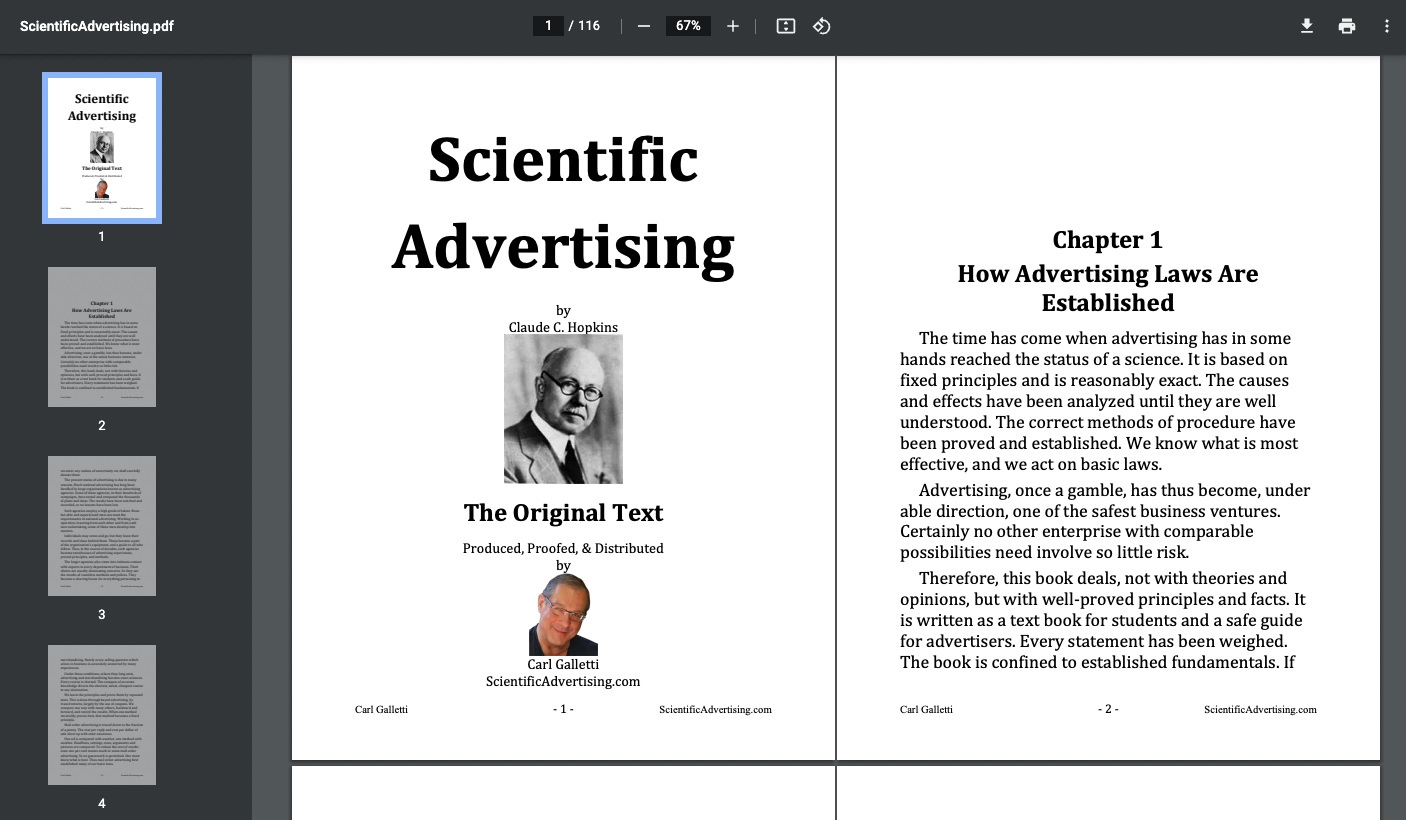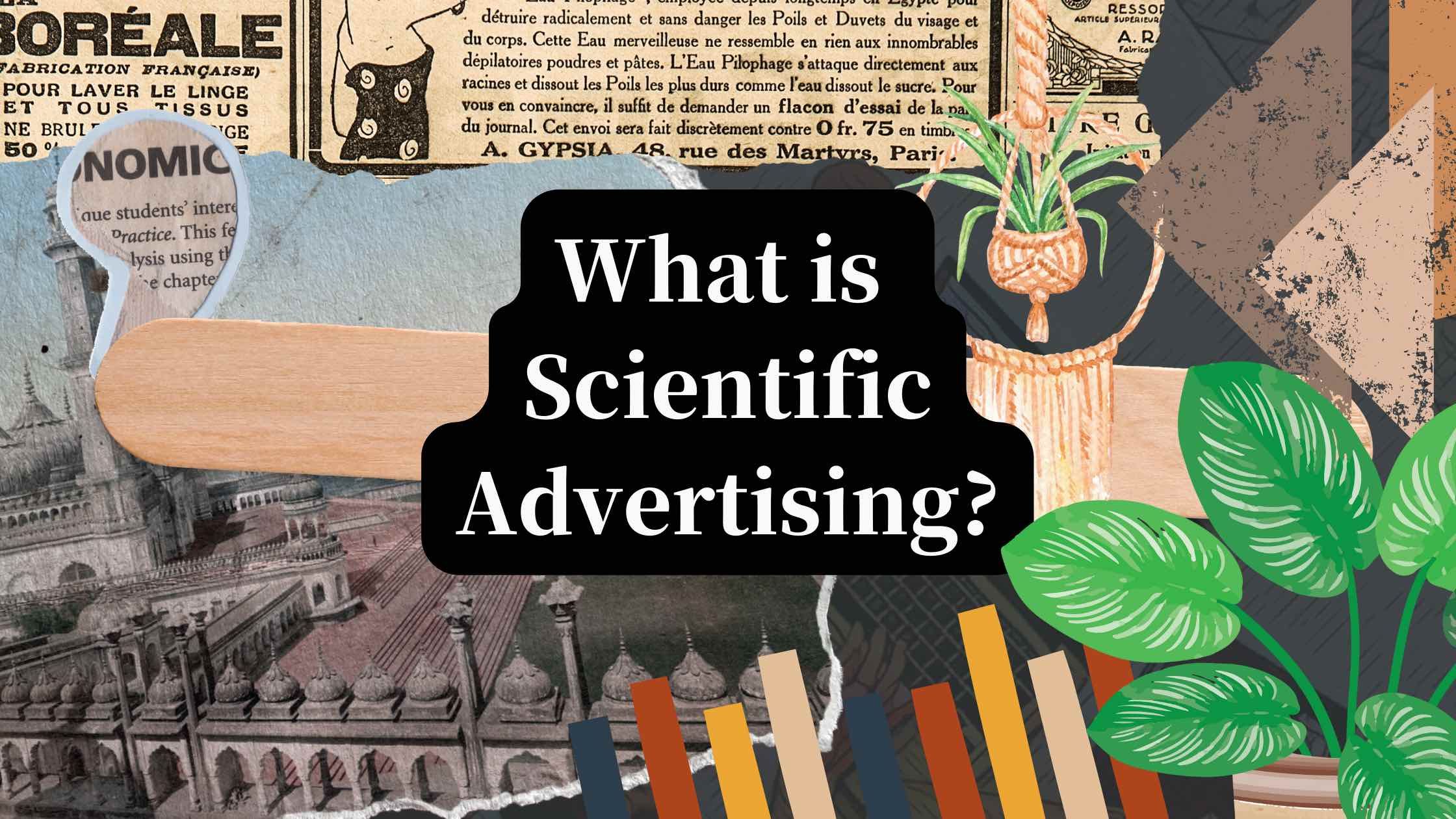If I told you I had a writing gig for you that paid $151 per word… would you want to hear more?
That’s how much money (in today’s dollars) companies would pay for top-notch sales copy in the roaring twenties, according to Scientific Advertising, a short book written by Claude Hopkins in 1923. Lauded by many legendary marketers and copywriters of the 20th century, Scientific Advertising’s status as one of the best copywriting books ever written continues in the digital age. The book is also public domain, which means you can read it in its entirety for free.
As Hopkins notes, “A salesman's mistake may cost little. An advertising mistake may cost a thousand times as much.” Copywriting is truly one of the most powerful skills an online professional can learn, and you don’t have to be an amazing writer to write amazing copy. What you need are science, structure, and story.
Key Takeaways
- Scientific Advertising was first released in 1923, and teaches what is known as direct marketing.
- Its perspectives on mail order advertising and samples inform modern advertising techniques.
- Hopkins champions the idea of the lowly copywriter, less charismatic than a salesman or executive, but directly responsible for the lion’s share of business interest.
- The principles taught in Scientific Advertising are timeless, and are still relevant today.
- Copywriting can quickly go south and become manipulate. Nevertheless, it is considered one of the greatest journalistic arts.
Here’s a bit more about the man behind Scientific Advertising, along with 5 important takeaways.
Who Was Claude Hopkins?
Born in 1866, Claude Hopkins was an advertising man, a copywriter, and, later, an author. Technically, his biggest contribution to advertising is that he introduced the idea of the slogan. In his writing and his work, however, his most trailblazing strategy was establishing coupons in mail order advertising as an attribution technique.
Related: Copywriting for Entrepreneurs: 10 Tricks for More Clicks
Hopkins was later hired by Lord & Thomas advertising agency owner Albert Lasker, whom many consider the father of modern advertising, as his techniques on leveraging consumer psychology largely changed both marketing and popular culture. Lasker, Hopkins, and other early 20th-century advertising professionals like David Ogilvy established baselines for many of the techniques we use in modern-day marketing and advertising.

Scientific Advertising is now public domain, you can read it for free at this link.

Lasker, in the lighter-colored coat, sitting next to then-President Warren G. Harding at Yankee Stadium on April 23, 1923. (Source: public domain)
Copywriting helps you form a selling argument, and there are stylistic options to explore. You could appeal to the happy and attractive side of a consumer’s personality, or you could appeal more to the dark and uninviting side. Ad writers in the 20th century knew that people judge largely on the mental impression they have of a product, not the product itself.
Too often, professionals new to marketing and young ad writers abandon the principles of good advertising. Simply claiming your offer is great is a costly mistake, and dismisses the human understanding you need for your copy to convert.
Let’s look at five of the most important takeaways Scientific Advertising has to offer.
No. 1: Clarity Trumps Persuasion
If you can tell a full story with clarity, you’ll have a better selling argument.
Most consumers have selfish purpose when scanning or consuming ads. Gain attention with complete advertisements that speak to human nature, and you’ll make more actual sales.
Here’s a screenshot of one of my favorite examples in Scientific Advertising, a print ad from the Mead Cycle Company in Chicago.

A print advertisement for Mead Cycle Company, used as an illustrative example in Hopkins' book.
In case that image is hard on your eyes, here's the text of the first paragraph:
“Try before you buy. Select the bicycle you prefer from the 44 styles, colors and sizes in the famous “Ranger” line. We send it on approval and 30 DAYS TRIAL, freight paid to your town. Return if not pleased and the trial costs you nothing.”
There is truly so much happening in this ad. There is a specific claim, there are concessions that cure trouble (like covering the cost of shipping), and the language follows simple principles. The owner of Mead Cycle Company once stated that this particular advertisement was so lucrative he didn’t change a single word.
Copy is your own best salesman, but for it to have strong appeal, it has to be clear.
No. 2: Track Reader Interest
Which headline is better, A or B?
If you don't have a way to measure your results and determine the most popular subject line, marketing is going to be an uphill battle.
We’re blessed to have a tremendous number of online marketing feedback loops at our fingertips. We can look at page views on a website, book sales, or email newsletter opens. We can see whether jumping on a popular trend in our messaging made a difference or not. Split testing and data attribution give you great advantages.
Claude Hopkins was a genius at split testing and attribution. In one campaign, a pre-Christmas ad for Bissell Carpet Sweeper Company that went out to 5,000 homes, twenty percent of recipients purchased. Hopkins measured feedback through coupon redemption rates and tracked phone calls; this is how split testing was done a century ago. Lucky for you, you only have to press a few buttons to create a similar feedback loop.
Important:Harvest feedback. Then do more of what works.
No. 3: Know How Human Brains Are Wired
Human motivation hasn’t changed much over the last hundred years. Consumers seek service, and the only purpose of copy is to grab and hold a person’s attention. As Claude Hopkins notes, once you learn the principles of human psychology, you’ll retain them for the life of your career.
Here are a few specific examples recommended in chapter six of Scientific Advertising to cultivate refreshing uniqueness — and more sales.
Curiosity
When you pique interest with unexpected and exciting details, you capture readers' attention and get them more emotionally invested in your work. Great advertising pioneers swear by this rule. This strategy was explored often in advertising pictures.
Guarantees
Humans like to stay on defense – especially when considering a purchase or investment. The opportunity to try a product risk-free erodes natural defense mechanisms in a buyer’s mind. Guarantees are a great advantage; they put the full weight of your confidence behind your offer, which people can pick up on.
Mattress company Nectar uses the psychology of guarantee to great effect. When Nectar wants to sell you a mattress, they offer you a 365-day trial, more than triple their industry competitors, and a pitch that has made the product famous. One version of their advert headline reads: “Which of these sounds better to you, a 100-day trial or a 365-day trial?” Nectar also uses the tagline “Take a year”. It’s a simple, emotionally arresting jingle, rooted in psychology.
Samples
In a series of fascinating examples, Hopkins found that when advertisements were structured so that the consumer could get a free sample whenever they wanted — rather than a spokesperson pandering the sample first — engagement improved. Some people see samples as negative advertising, but I think it’s great. It’s part of why we have a free tier in Camp Wordsmith, my web writing education platform.
It's kind of a paradox, really: People don't want to be sold to, yet they love to shop and buy. Even as photography, videography, and other forms of content production rise in popularity, these psychological triggers run the show behind the scenes, and are delivered well through writing.
No. 4: Relieve Tension
The unfortunate truth is that it’s much easier to identify a consumer’s pain and offer to remove it than it is to encourage precautionary measures. This doesn’t mean you have to be all doom and gloom, but you do want to elicit tension in some way when writing for others. Always keep this marketing maxim in mind: "Painkiller, not vitamin."
Many of Scientific Advertising’s examples still apply today. Toothpaste ads that promise whiter teeth outperform ones that tout the continued prevention of cavities. Soaps that promise more radiant, glowing skin will always outperform a headline like “keep clean”.
To encourage readers to act now and not later, focus on present-day inconveniences and how your product, program or service alleviates the trouble. This strategy results in more profitable ads, higher cost effectiveness, and more targeted advertising spend.
No. 5: Tell Complete Stories
A Nielsen report found that Americans spend an astonishing 11 hours and 27 minutes each day consuming media, a number that has risen year after year. That’s because the media prioritize stories. Stories captivate us, and they give your copy a great advantage.
Scientific Advertising notes that it’s an advertiser’s job to sell a complete story or proposition within a single ad, and then let the consumer decide if they are for or against the proposition. Whether you’re writing articles, social media captions, or advertisements, see if you can thread story into your writing.
Get More Scientific with Your Marketing and Advertising Today
No matter your industry of expertise, it’s a valuable use of time to learn and master the strategies that persuade people to click and read. The principles in Scientific Advertising are timeless and proven; put one or more of them into effect today, and watch the same amount of effort lead to more sales. ◆
Thanks For Reading 🙏🏼
Keep up the momentum with one or more of these next steps:
📣 Share this post with your network or a friend. Sharing helps spread the word, and posts are formatted to be both easy to read and easy to curate – you'll look savvy and informed.
📲 Hang out with me on another platform. I'm active on Medium, Instagram, and LinkedIn – if you're on any of those, say hello.
📬 Sign up for my free email list. This is where my best, most exclusive and most valuable content gets published. Use any of the signup boxes on the site.
🏕 Up your writing game: Camp Wordsmith® is a free online resources portal all about writing and media. Get instant access to resources and templates guaranteed to make your marketing hustle faster, better, easier, and more fun. Sign up for free here.
📊 Hire me for consulting. I provide 1-on-1 consultations through my company, Hefty Media Group. We're a certified diversity supplier with the National Gay & Lesbian Chamber of Commerce. Learn more here.


